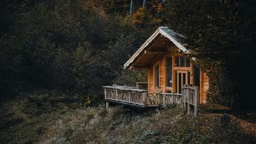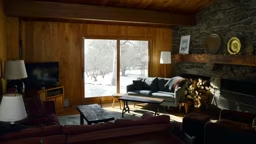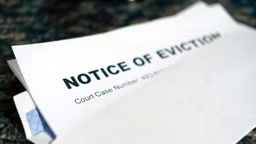
Cabin maintenance gets a bad rap. It’s a popular myth that cabins require more maintenance than traditional homes. But most log cabin maintenance is actually preventative: it’s about caring for your cabin now so that you won’t face serious (more expensive, time-consuming) issues in the future. As a cabin owner myself, there are a few key maintenance tasks that I make sure to check off the list each year. Checking off the items on this cabin maintenance list saves money and lots of headaches in the long run. Here are the top five items on my annual maintenance list:
1. Fill Checks in Your Logs
“Checks” are the cracks that occur naturally in logs as they settle and respond to structural pressures in our homes. Checks may be a few inches long or they may spread down the length of a log. If they grow too large, checks cause problems by allowing cold air, moisture, and pests into our homes.
What to do:
Keep an eye on the checks that form in your cabin. If they are larger than ¼ of an inch, fill them with caulk.
2. Clean Your Logs
The logs of our cabin go through a lot each year! They stand up to snow and ice in the winter and the blazing sun in the summer. Wind also carries dirt, pollen, and dust that collects on our logs. As part of your yearly maintenance, clean the exterior of your logs to remove the layer of dirt that forms from wind and weather.
If the dirt on your logs builds up for too long, it can create a layer that weakens your stain and traps moisture.
What to do:
Clean your logs at least once a year. Pressure washing is most popular for this, but be sure to consult the best practices for the type of logs and stain on your home.
3. Maintain Your Stain
The stain on your cabin protects your logs, so when it starts to deteriorate your logs are at risk for moisture and mildew. Throughout the year, watch your stain for signs of wear. The easiest way to spot issues with stain is to look for areas of discoloration, especially in areas of your home exposed to heavy snow or UV rays.
What to do:
Check your cabin thoroughly for signs of wear on your stain. Most stains last around 3 years, but it’s a good idea to inspect your stain yearly. If you do notice large patches of discoloration, it may be time for maintenance or a re-stain. And before applying stain to your cabin, don’t forget the important steps needed to prepare your cabin.
4. Check High-Moisture Areas
Certain areas around your cabin, like porches, decks, and spots with drainage or heavy rain, are more prone to moisture. Without proper protection, moisture can build up in these areas and lead to rot. Mildew, insects, and mold are all hazardous byproducts of rotting logs.
What to do:
Prevention is especially important when it comes to moisture! Make sure you have proper drainage systems in place, and that all water drains away from your logs. And keep your logs sealed, making sure that cracks and stains are maintained.
If you already have signs of moisture damage, in mild cases you can re-stain or re-seal logs to protect them. In more serious cases, log replacement may be needed.
5. Watch for Pests & Insects
Many insects and pests love our log cabins as much as we do: termites, carpenter ants, and carpenter bees are some prime suspects. You may not catch sight of these insects, but you can see what they leave behind: small holes in your logs.
As part of your maintenance routine, inspect your cabin for signs of unwanted insects. The most common sign is small, round holes in your logs.
What to do:
For holes already in your logs, fill them with caulk to prevent further damage. And if you still have signs of invasive bugs, consider using an insecticide or calling pest control. Read more here about pest prevention: 4 Tricks to Keep Bugs and Pests Out of Your Cabin.
Cabin maintenance is an ongoing task, but with this checklist you can be sure that you’re making progress on the most important items each year. Preventing problems before they occur is crucial in log cabins, and you’ll thank yourself later for keeping up with this concise list!










